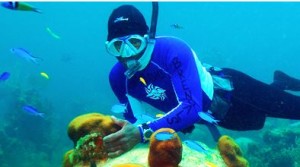Today, more and more people are rediscovering the simple joys of snorkeling and free diving, and it is hard to think of any destination more capable of satisfying everyone, from the casual snorkeler to the serious free diver, than The Bahamas.
The reasons are numerous. An unmatched water clarity combines with a striking spectrum of blues to create a highly attractive picture. The shallows sparkle with aquamarine and azure highlights bouncing off the white sand bottom. Virtually every professional dive operator offers dedicated snorkeling trips. In The Bahamas, every single island is surrounded by shallow reefs, many of which reach to within a few feet of the surface. Farther out, this same theme continues, with tens of thousands of shallow water sites on the banks peppered with coral heads and reefs.
In The Abacos, off the east side of the Little Bahamas Bank, the primary reef structures are seldom deeper than 30 to 40 feet. There are open cavern systems and excellent shallow wrecks. Bordering the north edge of Eleuthera is the infamous Devil’s Backbone, a jagged line of shallow reef that has come as an unwelcome surprise to many mariners.
Today it is a treasure for snorkelers. It offers tons of fish, lots of other marine life and a fascinating glimpse into history. Off the west side of Eleuthera is one of the most distinctive snorkel sites in The Bahamas—Current Cut.
Here, a relatively narrow cut runs from the bank to the outer waters. The current streams through this cut, creating a perfect feeding ground for marine animals. Harbour Island, off the east side, shares some fine reef structures.
South of Eleuthera is Cat Island, home to Dry Heads, one of the healthiest shallow reefs in the islands. Long Island offers a huge number of snorkeling possibilities. Shallow reefs are found right offshore, as well as at boat-accessible sites. The Exumas have some of the thickest concentrations of shallow reefs in The Bahamas, as well as shallow blue holes.
Bimini features fine shallow reefs, one great shallow wreck, the Sapona, and big animal experiences. Then there are the islands of the Bimini chain to the south and The Berry Islands (particularly Chub Cay) to the north of Bimini. There is excellent snorkeling off San Salvador, too. Snorkelers can also get in on The Bahamas dolphin and shark action. It’s the same in the southern Bimini chain, near Orange Cay.
These areas are both live-aboard territory.
Andros is also popular with snorkelers, offering shallow reefs, glimpses over the deep wall, inland blue holes and occasional dolphin encounters. This has been just a taste of the snorkeling opportunities available in The Bahamas.
On New Providence, there are numerous famous reefs on both the Northeast and Southwest sides of the island for snorkeling. A very popular snorkeling attraction is the Stuart Cove Shark Snorkeling Adventure, where snorkelers can actually swim with wild sharks! An amazing and fun family activity you will never forget.
Walls And Blue Holes
Those looking for something besides snorkeling can take advantage of the incredible blue holes, which are the result of centuries of freshwater dissolving and redepositing limestone. As a result, walls and blue holes are simultaneously special and widespread dive experiences in The Bahamas.
Walls, the most generally dramatic expression of the coral reef, will at times plummet directly into the great trenches thousands of feet deep that line the archipelago. Blue holes are found here in a greater number than anywhere on earth. And, The Bahamas has the only known tidal blue holes in the world. Together, the walls and blue holes turn The Bahamas dive experience on its side.
Walls are found throughout The Bahamas and their profiles range from those that end at sand bottoms 60 to 100 feet deep, to seemingly infinite vertical descents. It is along these escarpments of the deep reef that the majesty of coral spires and the magnificence of sponges is fully realized. Seafans, bryozoans, seawhips and Black Coral mix and mingle with the sponges, creating a garden carpet of life. More color and the addition of motion is provided from solitary and schooling reef fish. Every wall is similar, yet different: profile, shape, size and predominant colors vary from site to site.
The following walls are among the most stunning, popular and accessible in The Bahamas.
The Islands of the Bahamas, www.bahamas.com

